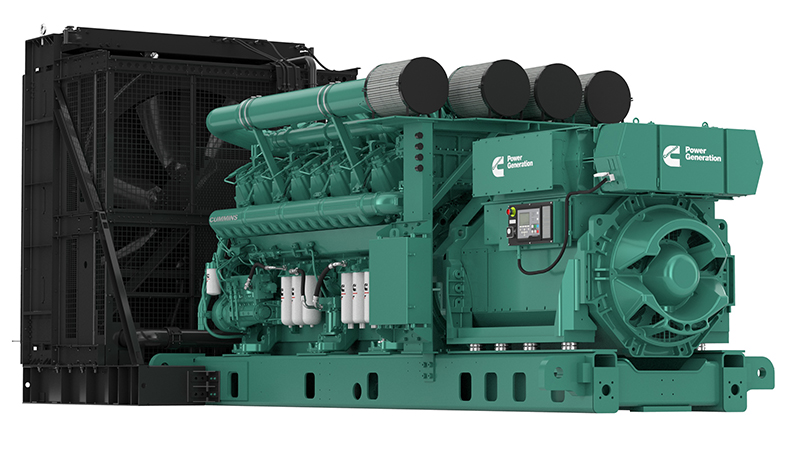Hydrotreated Vegetable Oil (HVO) Explained
You have questions about Hydrotreated Vegetable Oil (HVO), we have answers.
By Catherine Morgenstern, Brand Journalist


Hydrotreated Vegetable Oil (HVO) is a diesel-like fuel that can be produced without fossil resources by processing renewable waste lipids. Cummins offers an entire line of diesel generator sets that are approved for use with paraffinic fuels such as HVO in Power Generation standby applications. This provides a simple and efficient alternative to diesel for both new and existing fleets of generator sets. This lower-carbon option enables Cummins customers, like Microsoft Corporation, to progress towards their decarbonization goals.
Vipul Tandon, Executive Director of Global Power Generation at Cummins Inc., stated that they are pleased to collaborate with Microsoft as a valued partner. This partnership supports Microsoft's goals for cleaner power and leverages Cummins' 100 years of experience in integrating power system solutions with advancing technologies. This experience has provided us the flexibility to meet and exceed changing global standards, as well as the unique requirements of our customers.”
Here are answers to a few commonly asked questions about this new alternative fuel:
What are paraffinic fuels?
Paraffinic fuels are an alternative to diesel with low sulfur and aromatics. They are derived from a variety of sources, the most common including natural gas, coal, plant oils and animal fats.
What is HVO?
HVO, also known as renewable diesel or green diesel, is created from lipids like vegetable oil, tallow, or used cooking oil. These lipids are made of paraffinic hydrocarbons and result in a low carbon fuel.
What are the differences between HVO and diesel?
HVO fuel has similar chemical and physical properties to diesel fuel. However, its fossil-free composition and low carbon content make it an appealing sustainable fuel option, differentiating it from diesel. HVO also has approximately 7% less fuel density, limited aromatic and sulfur content, and a higher cetane value versus diesel fuel. Despite these differences, HVO can be blended with diesel in any proportion. This ease of integration is particularly beneficial in standby generator set applications, where stored fuel consumption is low.
Is HVO different from biodiesel?
While HVO is derived from the same feedstocks used to produce biodiesel, it is produced via a hydrotreated process vs. transesterification process which helps improve its oxidation stability. This means that HVO is not prone to bacterial growth in comparison with biodiesel, making HVO a great, sustainable option for generator sets in standby applications.
Isn’t HVO the same as all the gas-to-liquids (GTL) fuels?
Physically and chemically, these fuels are the same fuel and meet the EN 15940 fuel specification. HVO has a lower life cycle carbon emission compared to GTL fuels though. This is because HVO is produced from renewable feedstocks, while GTL fuels are produced from natural gas, a fossil fuel.
What performance is expected when running Cummins generator sets on HVO fuel?
The detailed results of several tests conducted are published in a white paper that outlines the expected generator set performance when running on HVO fuel vs. diesel fuel. EPA Tier 2 and TA Luft certifications remain valid with operation on HVO fuel.
What changes are needed to upfit existing Cummins generator sets to run on HVO fuel?
No changes or modifications to hardware or software are needed to run approved Cummins engines and generator sets on HVO fuels. Further Cummins standard and extended warranties apply on any generator sets approved to run on HVO fuel.
How readily available and widely adopted is HVO?
As a relatively new fuel source, the rate of adoption of HVO today is limited by its supply chain and higher cost, with higher adoption in markets where the use of diesel is curtailed. Supply chains are developing to serve these regulated markets, predominantly in parts of North America and Europe. Increasing demand driven by a combination of regulatory and customer ESG targets will drive increased production, which will subsequently lead to increased adoption. The IEA Renewables 2020 report predicts that the average output in 2023-2025 will be 63 billion L, a 30% increase from the 2019 level. The majority of this increase is attributed to expanding HVO production in Singapore and the United States.
Here are some additional frequently asked questions about HVO (PDF).
Learn about the benefits of alternative fuels and fuel flexibility.
Learn more about Cummins' Destination Zero strategy and our mission to power a more prosperous world.
Author Profiles

Catherine Morgenstern, Brand Journalist
Catherine Morgenstern is a Brand Journalist for Cummins, covering topics such as alternative propulsion, digitalization, manufacturing innovation, autonomy, sustainability, and workplace trends. She has more than 20 years of experience in corporate communications, holding leadership positions most recently within the Industrial Capital Goods sector. Catherine began her career as a marketing writer for a biotechnology company, where she learned to take complicated and highly technical information and make it accessible to everyone. She believes the concept of “storytelling” is more than a trendy buzzword and loves to find ways for her readers to make personal connections to her subjects. Catherine has a passion for technology and innovation and how its intersection can make an impact in all our lives. Catherine recently moved back to her hometown in the Hudson Valley, New York after a several decades in Los Angeles and Chicago. She is a graduate of UCLA and enjoys gardening and spending time with her husband and three children.
Related Topics
Related Tags